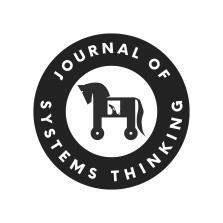This paper is an excellent overview of the history of systems thinking from mid 20th century onward. It covers 4 waves of systems thinking, and DSRP.
The four waves, roughly summarised are:
- First wave: systems as real-world things - system dynamics, physical science focus
- Second wave: systems as mental models - this wave was more social-science driven
- Third wave: critical systems thinking - bringing critical theory to systems thinking, focused on critique of boundary definitions, and on power in relationships
- Fourth wave: universalisation - trying to pull all the threads together from diverse approaches (this wave is starting, may not happen)
The authors suggest that DSRP is a potential core framework for the fourth wave. DSRP summarised:
- 4 structures, each made of 2 elements, mutually defining
- A Distinction (D) is defined as identity (i) co-implying an other (o)
- A System (S) is defined as part (p) co-implying a whole (w)
- A Relationship ® is defined as action (a) co-implying a reaction ®
- A Perspective (P) is defined as point (ṗ) co-implying a view (v)
- My understanding is that the first two structures both define the boundaries of the system as a whole, and of the individual components of a system (e.g. actors).
- DSRP kind of assumes that all system components are also entire systems within themselves (e.g. humans are actors in a social system, but a human is also a system of cells, etc.)
- M = I ⊗ T
- a mental model (M) is the complex product (⊗) of information (I) and DSRP simple structural rules of thinking (T) (listed above)
- Four levels of depth of abstraction:
- Atomic Structures: The universal components that can’t be broken down further.
- These are the 4x2 component structures of DSRP, listed above.
- Molecular structures, or “jigs” or “moves”: Abstractions of mental models.
- “Jig” as in a work-tool that helps you build something. “Move” as in martial arts or dancing - patterns that repeatedly appear.
- These are thinking-patterns that are basically information-less models. Often these can be discovered by abstracting from the next level (conceptual models).
- Examples: 2x2 table of considerations - this appears in lots of types of thinking.
- There’s a big list at https://help.cabreraresearch.org/moves-glossary
- Compound structures: Conceptual models that include molecular structures AND information.
- e.g. any applied model. Traffic optimisation models. SWOT analysis (this is a specific example of a 2x2 table)
- Any person, any system:
- They claim this represents all knowledge, but I think it only represents all thinking (maybe).
- Atomic Structures: The universal components that can’t be broken down further.
You must log in or register to comment.

